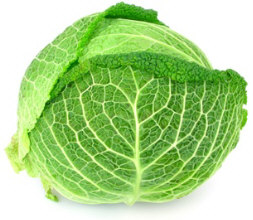Savoy Cabbage
(Wirsing, Wirsching, Welschkohl, Savoyer Kohl, or Börschkohl)
Savoy cabbage belongs to the cabbage family and is similar to both green cabbage and red cabbage. Its head consists of loose, light green to dark green leaves which show crinkled vein patterns. Savoy cabbage is milder in flavor than green and red cabbage, and can often replace these cabbage varieties.
Savoy cabbage is believed to have originated from England and Holland. Savoy cabbage was introduced into Germany in the 18th century. It was originally known as "Savoyer Kohl" because it came to Germany from the Savoy ruled region of north-western Italy. The name later changed to "Wirsing," which most likely stemmed from the word "verza," the italian name for savoy cabbage.
Preparing Savoy Cabbage
Savoy cabbage is very versatile in cooking because its leaves are more tender than other cabbage varieties, especially the inner, light colored leaves. These are fully cooked in just a few minutes and work well as a vegetable side dish to many dishes, such as game, roasts, liver, and fish. Other popular uses include stuffed cabbage leaves, stew, and soup.
To prepare, cut out the stem of the saboy cabbage, then remove the outer leaves. Be sure to give the cabbage a good washing because sand can sometimes get trapped between the leaves.
Nutritional Information
Savoy cabbage is a low-calorie and nutrient-rich vegetable. 3.5 ounces (100g) of raw cauliflower has only 31 calories. It also contains protein, iron, phosphorus, vitamin A, vitamins B1, B2, B3, B5, and B6, and vitamin C.
Selecting and Storing Savoy Cabbage
When selecting, select a savoy cabbage that feels heavy and with leaves that are crisp, fresh, and have no discolorations.
Store savoy cabbage in the refrigerator. It will remain fresh for up to a week.
|

Photo: © kmit - Fotolia.com
|

